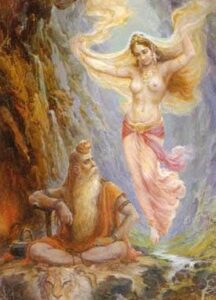Showing not Telling
Showing not Telling
Showing not Telling
‘Showing not Telling’ is a hackneyed but significant term in creative writing. It is concerned with the style of representing the subject matter of an author that he goes on to treat in his writing. ‘Show’ refers to depicting a thing or event in a lively way that leaves an impression (image) in the mind of the reader. It presents observed details and allows readers to draw their conclusions from the details. On the other hand, ‘Tell’ refers to narrating an event that directs the theme to a point. It typically involves presenting conclusions of an event. For illustration we can take the following two examples:
(a) Kanak dressed well and went to the theatre.
(b) Kanak wore his black jeans pants, a brown coat over his green shirt, wrapped his throat up with a black scarp, put his three-cornered silk cap on his head and put the sunglass on his eyes, and went to the theatre.
The first sentence of the above two examples is a ‘Tell’ sentence and the second one is a ‘Show’ sentence. It is because the first sentence “Kanak dressed well and went to the theatre” is a conclusion that sums up a large number of previously observed facts and leaves little to be said and the phrase “dressed well” is vague to create an image in the mind of the reader. On the other hand, the second sentence is a ‘Show’ one because here Kanak’s dressing is shown in detail creating an image in the mind of the reader from which the reader can conclude that Kanak was well dressed.
To clarify the difference between ‘Telling Sentence’ and ‘Showing Sentence’ we can take more examples as below:
(a) That was an uncomfortable evening. (Tell Sentence)
(b) That evening was a cold one as it was drizzling, the sea wind was blowing heavily, the sky was damp and the sun was off. (Show Sentence)
The first sentence is a ‘tell’ sentence as there is no detail of why that evening was uncomfortable. But in the second sentence, we get a detail of why that evening was uncomfortable. Therefore the second sentence creates an image of uncomfortable weather on that particular evening in the mind of the reader.
In creative writing there is a great significance of ‘showing’ sentences as ‘showing’ sentences play the following positive roles in writing:
First, ‘show sentence’ adds the quality of vividness, freshness, and liveliness to any writing and which in turn imparts reliability to fiction and then the reader feels the events to be going on in front of his eyes and consequently they create a mental picture in the reader’s mind.
Secondly, when readers get a clear picture, they are more engaged in the writer’s story.
Thirdly ‘showing sentence’ adds gravity and slowness to the movements of an event for which the reader gets time to feel, evaluate, and enjoy the author’s message.
Fourthly, showing is more informative and interesting than telling.
Fifthly, showing imparts objectivity to writing.
In brief to say, ‘showing’ is a movie, and ‘telling’ is a news summary.
There are some means of showing (things, events) in writing as- (1) description of the action (including gesture, physical movements) in representing things, (2) use of figures of speech to illustrate a theme or action, (3) the use of specified items of things and (4) the use of strong verb and appropriate phrases than using weak verbs followed by adjectives. Let us illustrate this below:
Description of Action refers to the act of giving a detailed account of an event or happening. It includes gestures and physical movements also. For illustration, we can take the following two examples:
- (a) the peasants were walking on laboriously towards the market.
(b) The men were proceeding with slow steps, the whole body bent forward at each movement of their long twisted legs, deformed by their hard work, by the weight on the plough, which, at the same time, raised the left shoulder and swerved the figure, by the reaping of the wheat which made the knees spread in order to hold the wheat firmly, by the slow and painful labours of the country. Their blue blouses, ornamented with a little design in white at the neck and wrists, puffed about their bony bodies, and seemed like balloons ready to carry them off. From each of them, a head and two arms and two legs protruded. (An Exquisite example of Showing from Guy de Maupassant’s short story ‘A Piece of String’)
- (a) When school began there was a great bustle. (Telling)
(b) Usually when school began, there was a great bustle, which could be heard out in the street, the opening and closing of desks, lessons repeated in unison, very loud, with our hands over our ears to understand better, and the teacher’s great ruler rapping on the table. (Showing) (Alphonse Daudet: The Last Lesson)
Of the above quoted two excerpts, the first one is a ‘tell’ sentence as in this sentence the author draws a conclusion after his observation of the manner of walking of the peasants but he has omitted to give a detail of his observation. But the second description is an example of ‘show’ sentences because in these sentences the author has given a vivid detail of his observation of how the peasants were walking ahead and why they were walking on laboriously.
Showing events in writing is often done through using imagery (figures of speech). Imageries may be – (i) auditory (hearing), (ii) gustatory (taste), (iii) olfactory (smell), (iv) tactile (touch), (v) thermal (by which we differentiate between heat and cold) and (vi) kinesthetic (which is produced by muscular tension or movement). The use of imageries affects our sense organs and thus makes our enjoyment and perception more and more lively and interesting. In creative writings (both in prose fiction and poetry) the authors very often use similes and metaphors in detailing their matter. For example, we can take the following two sentences:
- (a) Sita bears black hair. (Tell)
(b) Sita’s hair is as black as the evening cloud in the spring season.
The above-quoted sentence no. 1 (a) is a ‘tell’ sentence and sentence no.1 (b) is a ‘show’ sentence as by comparing the hair of Sita with the black cloud in spring, an image is created in the mind of the reader.
The third means of showing things in writing is the use of specified terms instead of using general terms. For example:
- (a) He provided us with a delicious breakfast.
(b) He provided us with bananas, cheese, apples, grapes and pizza for breakfast.
- (a) It was a flower. (Tell)
(b) It was a rose. (Show)
In the above quoted first sentence, ‘delicious breakfast’ is a general term. It does not create any vivid picture in the mind of the hearers. On the other hand, the food item which tastes delicious is specified as – banana, cheese, apple, grapes and pizza in the second sentence and hence the second sentence is an example of ‘show’ sentence and the first sentence is a ‘tell’ sentence.
The fourth means of showing something is done by using an appropriate and strong verb. In doing so the speaker or writer should avoid too much use of adjectives and instead, he should use specified verbs that can express apparent and exact meaning without taking an adjective or adverb. . For example, let us consider the following two expressions:
- (a) Radha gave suppressed laughter.
(b) Radha giggled.
- (a) Ram looked obliquely at me.
(b) Ram squinted at me.
Here the verb ‘giggled’ in sentence no 1. (b), and the verb ‘squinted’ in sentence no 2. (b) are stronger than the verb ‘laughter’ followed by the adjective ‘suppressed’ and the verb ‘looked’ followed by the adjective ‘obliquely.’
From the above illustration, it is clarified that ‘Showing’ not ‘Telling’ makes a piece of creative writing more vivid, life-like, realistic, reliable, interesting, engaging and enjoyable. Now a curious question arises: is there not any place or significance of ‘Telling’ in creative writing? To its answer, it is to say that in creative writing there is also a place of ‘telling’ because only showing makes a piece of writing, long, prolix and wearisome. The author should use the ‘show’ method in representing and revealing his central theme and main characters or something which the thinks to be important to meet his purpose and all the subordinate things, event, and allusions should be presented through telling. For example, R. K Narayan in his short story entitled ‘Father’s Help’ has used the ‘show’ method in presenting his main character ‘Swaminathan’ and in presenting all the remaining characters, he has employed the ‘telling’ method. 0 0 0.
Showing not Telling
You May Like: Imagery | Classification of Imagery
Showing not Telling
Books on Literary Criticism by M. Menonimus:
- World Short Story Criticism
- World Poetry Criticism
- World Drama Criticism
- World Novel Criticism
- World Essay Criticism
- Indian English Poetry Criticism
- Indian English Poets and Poetry Chief Features
- Emily Dickinson’s Poetry-A Thematic Study
- Walt Whitman’s Poetry-A Thematic Study
- Critical Essays on English Poetry
- Tawfiq al-Hakim’s Novel: Return of the Spirit-An Analytical Study
- Tawfiq al-Hakim’s Novel: ‘Yawmiyyat Naib Fil Arayaf’-An Analytical Study
- Analytical Studies of Some Arabic Short Stories
- A Brief History of Arabic Literature: Pre-Islamic Period (500 AD-622 AD)
- A Brief History of Arabic Literature: Early Islamic Period (622 AD-661 AD) …
Related Search:
- Imagery: Definition and Examples
- Show Don’t Tell
- Show not tell: How to Write Effective Exposition
- Imagery as a Literary Device
- What is Imagery











